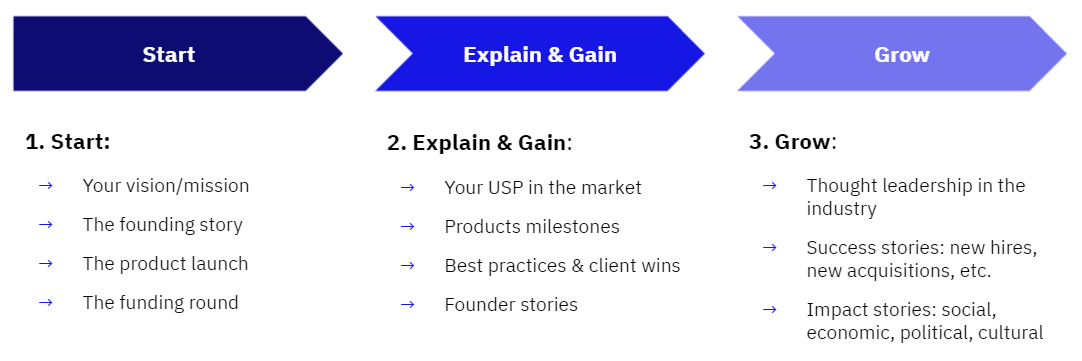By Tobias Enke, Public Relations Specialist @Project A
Your initial funding announcement is out and now what? Don’t stop communicating because PR is a long-term game. Ideally, you should constantly sharpen your public perception and develop your company’s narrative.
Here is why PR matters, how you can stay relevant and what to consider along the way.
Why PR matters
Public Relations is more than just getting an article published in Techcrunch. It’s about convincing people of what you do. It translates your vision and product and gives your audience a deeper understanding of your company and brand.
Public Relations is not only about making you look good in the media. It serves a wider purpose within your organization as it defines how your company speaks to the outside world. PR creates, amplifies and sometimes has to protect the reputation of your company.
Public Relations is not self-serving: it requires a strategy: How do you want to be perceived in the media? Who do you want to address, what are your key messages and why is this important to anyone out there?
Public Relations is an important channel to send positive signals into the market, attract new investors, stakeholders and customers alike.
Public Relations is “earned media”. Great news, because you don’t need big budgets for it!
How to be/stay relevant
Relevance is one of the key goals of your PR strategy: Show that your company and your views matter, talk about how you’re changing your industry and what you do differently, and let people out there see what kind of an employer you are.
To be relevant, you need to provide real newsworthy stories or insights. Aside from making corporate or funding announcements, try tapping into your consumers’ behavioural trends, new or emerging ways of approaching a problem or cultural and societal topics that your business could address. Talk about the broader picture of an industry and how you are changing it.
The different phases of a startup require specific communications efforts:

In the beginning, it’s important to let people know that you as a company exist — and also why. State your vision and what you want to do differently from others. Product launches and funding rounds are ideal hooks to provide the necessary newsworthiness.
You already have some initial traction, but your products need to be understood better? PR is not a marketing vehicle but it can serve to create a beacon for potential customers. Constant drops wear the stone: Use best practices, product milestones and client wins to inform people about your progress. And make sure to highlight the personal brand of your founders.
At a certain point, you might grow fast and build a reputation. While growing, it is imperative to incorporate that growth in your narrative. Highlighting that you are a thought leader in the industry is a good way of showing what you are about. Use speaking opportunities at industry events, do interviews on the bigger picture of your industry and communicate your growth transparently. Now you can also focus on impact stories and how your business contributes to society.
Remember: There’s no end to PR. It’s always ongoing. Here are some Do’s and Don’ts to keep in mind along the way.
Do’s and Don’ts
- Always keep it short and simple, think of journalists as generalists who won’t know as much as you do on the matter and who receive dozens of media pitches every day.
- Build relationships with journalists: depending on your industry, there are sometimes only a handful of journalists who cover your topic at the big media outlets. Keep them up to date, but don’t always expect coverage.
- Establish context and create stories: Don’t talk only about yourself, but the market, the implications your business has for it and why you are better than competitors (numbers count!).
- Create a narrative framework reflecting your company’s vision. These are some examples from Project A’s portfolio:
Democratizing financial markets (Trade Republic)
Seeing a doctor without having to go to one (Kry)
How to sell houses in the future (Casavo)
- Be consistent: Always stick to your key messaging and repeat it whenever possible to make sure it catches on.
- Show that you’re an expert on the topics within your narrative and comment on current developments, updates, policies, etc. in your industry.
- Use other formats besides press releases: social media, opinion pieces, events, blogs, podcasts are all great additions to show your expertise.
- Stay active, don’t just communicate your funding and nothing else. PR is constantly ongoing. But don’t overdo it with a load of irrelevant press releases.
- Don’t be like all the others: In a sea of sameness, try to stick out and find messages to differentiate yourself from your competitors.
- You can use freelancers or your VC’s support team at first, in-source later as the company grows. If you operate in a highly regulated business area, invest in a PR professional very early on.
- Any PR person who claims he or she “will get you into TechCrunch”, is lying. Coverage is never guaranteed, it depends on your story, whether it captures the zeitgeist, it also depends on the quality of your media relationships and the narrative you build around the problem that your startup is supposed to solve.
- Media works differently in each market. Adapt your approach to local needs, don’t do mass mailings.
For anything else, follow the playbook on How to tell stories about your startup beyond funding by Mike Butcher.